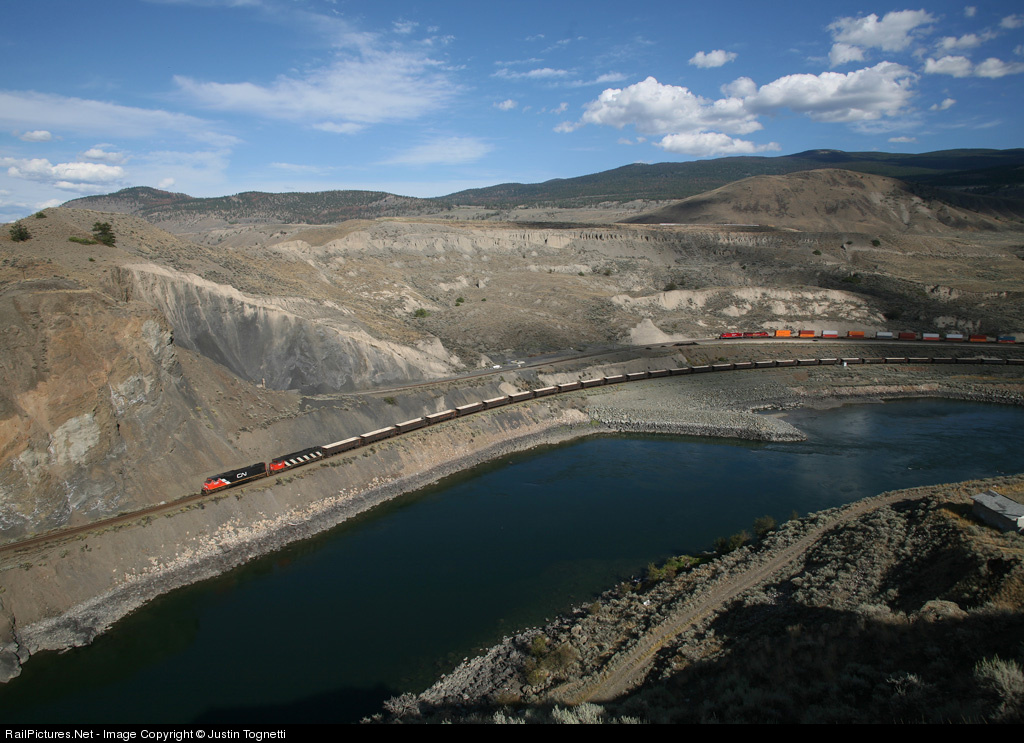 Consider first this image by Justin Tognetti (captioned version here; more of his work here). The train is pretty small, but this is obviously a train shot, in fact, two trains appear. The scene is basic, terrain, water, sky. I just love the way the front of the more distant train is framed by cloud shadows, which also gives it a more distinct identity relative to the first. The terrain has lots of interesting textures and hues and the two trains have a bit of lower left / upper right positioning. Very nice!
Consider first this image by Justin Tognetti (captioned version here; more of his work here). The train is pretty small, but this is obviously a train shot, in fact, two trains appear. The scene is basic, terrain, water, sky. I just love the way the front of the more distant train is framed by cloud shadows, which also gives it a more distinct identity relative to the first. The terrain has lots of interesting textures and hues and the two trains have a bit of lower left / upper right positioning. Very nice! But the train need not be such an obvious part of the image. This boat shot is by Gerald Oliveto (captioned version here; more of his work here). The light is nice and the color of the water is subtly gorgeous. But the train is difficult to find (and would be more difficult but for the precise framing of the power in front of a brighter spot of water). It's an interesting scene, but not particularly a railroad image, as the train is barely visible. (For my tastes, had the shot been a bit wider, so that the boat was less squeezed and more of the marina were present on the left, it may have had better balance.)
But the train need not be such an obvious part of the image. This boat shot is by Gerald Oliveto (captioned version here; more of his work here). The light is nice and the color of the water is subtly gorgeous. But the train is difficult to find (and would be more difficult but for the precise framing of the power in front of a brighter spot of water). It's an interesting scene, but not particularly a railroad image, as the train is barely visible. (For my tastes, had the shot been a bit wider, so that the boat was less squeezed and more of the marina were present on the left, it may have had better balance.)Both of those shots are landscape scenes. Instead, a shot can be more abstract. Here is one by Tom Mugnano (captioned version here; more of his work here).
 The train has a subtle presence here, but a bit stronger (and it is hard for me to judge since I know the location well and therefore the train is more obvious to me). What I find interesting is the layout of the town - all the blocks and buildings (and windows within them) give the shot a bit of an abstract feel. It reminds me of shots I have seen and taken, from a much lower angle, across an old European cities with a series of tile roofs. Lots of rectangles and such.
The train has a subtle presence here, but a bit stronger (and it is hard for me to judge since I know the location well and therefore the train is more obvious to me). What I find interesting is the layout of the town - all the blocks and buildings (and windows within them) give the shot a bit of an abstract feel. It reminds me of shots I have seen and taken, from a much lower angle, across an old European cities with a series of tile roofs. Lots of rectangles and such.So, then, how does one consider this image, by Graham Williams (more of his work here)?
 This is the image that first compelled me to contemplate this subject. The scene lacks an obvious subject - there are a number of elements, (short) train, village, windmills, isolated farms, trees. One could say the scene is the scene, or that the scene is a pastiche of things, one of which happens to be a train. I happen to find this scene pretty, in a way, and interesting, in that my eye dances around the scene. At the same time, my eye doesn't stop much; perhaps I can exaggerate and call it an anti-composition because it lacks form. It's a jumble of elements with only tangential relationships to each other, in my view, but it all works for me. It's pleasant, it's interesting to look at. It's not a great shot, but it is a nice shot, and it's a bit off the beaten path of scenics, so it is inherently interesting.
This is the image that first compelled me to contemplate this subject. The scene lacks an obvious subject - there are a number of elements, (short) train, village, windmills, isolated farms, trees. One could say the scene is the scene, or that the scene is a pastiche of things, one of which happens to be a train. I happen to find this scene pretty, in a way, and interesting, in that my eye dances around the scene. At the same time, my eye doesn't stop much; perhaps I can exaggerate and call it an anti-composition because it lacks form. It's a jumble of elements with only tangential relationships to each other, in my view, but it all works for me. It's pleasant, it's interesting to look at. It's not a great shot, but it is a nice shot, and it's a bit off the beaten path of scenics, so it is inherently interesting.



No comments:
Post a Comment